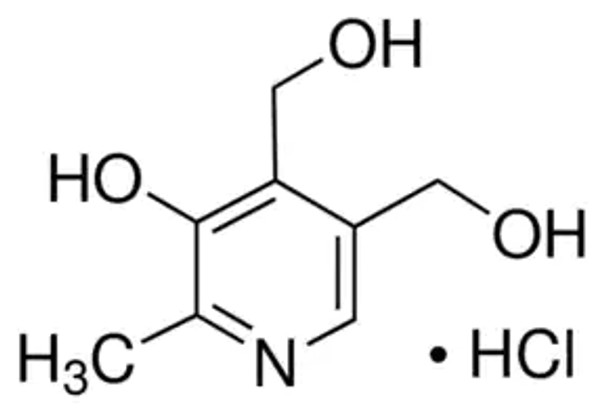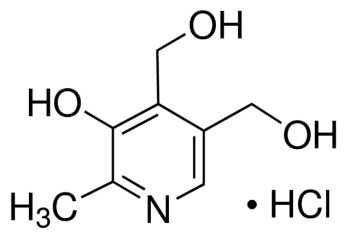Description
Pyridoxine hydrochloride, USP, 10G
meets USP testing specifications
Synonym(s):
Adermine hydrochloride, Vitamin B6 hydrochloride, PN HCl, Pyridoxol hydrochloride
Empirical Formula (Hill Notation):
C8H11NO3 · HCl
CAS Number:
58-56-0
Molecular Weight:
205.64
Beilstein:
3632435
EC Number:
200-386-2
MDL number:
MFCD00012807
eCl@ss:
34058008
PubChem Substance ID:
24898493
NACRES:
NA.21
PROPERTIES
Quality Level
200
biological source
synthetic (organic)
Agency
USP/NF
meets USP testing specifications
assay
98.0-102.0% dry basis
form
powder
color
white
mp
214-215 °C (lit.)
application(s)
pharmaceutical (small molecule)
SMILES string
Cl[H].Cc1ncc(CO)c(CO)c1O
InChI
1S/C8H11NO3.ClH/c1-5-8(12)7(4-11)6(3-10)2-9-5;/h2,10-12H,3-4H2,1H3;1H
InChI key
ZUFQODAHGAHPFQ-UHFFFAOYSA-N
General description
Vitamin B group is water-soluble and exists in six forms namely the pyridoxal, pyridoxine, pyridoxamine, pyridoxamine 5′-phosphate, pyridoxine 5′-phosphate and pyridoxal 5′-phosphate. The food sources of vitamin B6 include grains, nuts, fruits, vegetables and meat.
Application
Pyridoxine hydrochloride has been used to test its neuroprotective functionality in traumatic brain injury (TBI) rats. It has also been used as a reference standard to quantify vitamin B6 in feed and digesta samples using high-performance liquid chromatography(HPLC).
Packaging
10, 100 g in poly bottle
Biochem/physiol Actions
Pyridoxine plays a key role in metabolism both carbohydrates and amino acids. It supports brain development and its deficiency levels may lead to depletion of γ-aminobutyric acid (GABA) levels. Pyridoxine catalyzes the neurotransmitter biosynthesis like dopamine and serotonin. Pyridoxine in excess or deficient may lead to neuropathy.
SAFETY INFORMATION
Signal Word
Danger
Hazard Statements
H318
Precautionary Statements
P280 - P305 + P351 + P338
Hazard Classifications
Eye Dam. 1
Storage Class Code
11 - Combustible Solids
WGK
WGK 1
Personal Protective Equipment
dust mask type N95 (US), Eyeshields, Gloves





